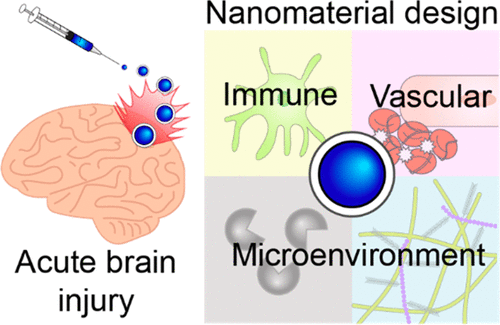当前位置:
X-MOL 学术
›
Mol. Pharmaceutics
›
论文详情
Our official English website, www.x-mol.net, welcomes your feedback! (Note: you will need to create a separate account there.)
Nanomedicine for Acute Brain Injuries: Insight from Decades of Cancer Nanomedicine
Molecular Pharmaceutics ( IF 4.9 ) Pub Date : 2020-06-25 , DOI: 10.1021/acs.molpharmaceut.0c00287 Rebecca M. Kandell , Lauren E. Waggoner , Ester J. Kwon
Molecular Pharmaceutics ( IF 4.9 ) Pub Date : 2020-06-25 , DOI: 10.1021/acs.molpharmaceut.0c00287 Rebecca M. Kandell , Lauren E. Waggoner , Ester J. Kwon

|
Acute brain injuries such as traumatic brain injury and stroke affect 85 million people a year worldwide, and many survivors suffer from long-term physical, cognitive, or psychosocial impairments. There are few FDA-approved therapies that are effective at preventing, halting, or ameliorating the state of disease in the brain after acute brain injury. To address this unmet need, one potential strategy is to leverage the unique physical and biological properties of nanomaterials. Decades of cancer nanomedicine research can serve as a blueprint for innovation in brain injury nanomedicines, both to emulate the successes and also to avoid potential pitfalls. In this review, we discuss how shared disease physiology between cancer and acute brain injuries can inform the design of novel nanomedicines for acute brain injuries. These disease hallmarks include dysregulated vasculature, an altered microenvironment, and changes in the immune system. We discuss several nanomaterial strategies that can be engineered to exploit these disease hallmarks, for example, passive accumulation, active targeting of disease-associated signals, bioresponsive designs that are “smart”, and immune interactions.
中文翻译:

纳米医学治疗急性脑损伤:数十年癌症纳米医学的见解
创伤性脑损伤和中风等急性脑损伤每年影响全球 8500 万人,许多幸存者患有长期的身体、认知或心理障碍。FDA 批准的疗法很少能有效预防、阻止或改善急性脑损伤后大脑的疾病状态。为了解决这一未满足的需求,一种潜在的策略是利用纳米材料独特的物理和生物特性。数十年的癌症纳米医学研究可以作为脑损伤纳米医学创新的蓝图,既可以效仿成功的经验,也可以避免潜在的陷阱。在这篇综述中,我们讨论了癌症和急性脑损伤之间共有的疾病生理学如何为治疗急性脑损伤的新型纳米药物的设计提供信息。这些疾病特征包括脉管系统失调、微环境改变和免疫系统变化。我们讨论了几种可以利用这些疾病特征的纳米材料策略,例如被动积累、主动靶向疾病相关信号、“智能”生物响应设计以及免疫相互作用。
更新日期:2020-06-25
中文翻译:

纳米医学治疗急性脑损伤:数十年癌症纳米医学的见解
创伤性脑损伤和中风等急性脑损伤每年影响全球 8500 万人,许多幸存者患有长期的身体、认知或心理障碍。FDA 批准的疗法很少能有效预防、阻止或改善急性脑损伤后大脑的疾病状态。为了解决这一未满足的需求,一种潜在的策略是利用纳米材料独特的物理和生物特性。数十年的癌症纳米医学研究可以作为脑损伤纳米医学创新的蓝图,既可以效仿成功的经验,也可以避免潜在的陷阱。在这篇综述中,我们讨论了癌症和急性脑损伤之间共有的疾病生理学如何为治疗急性脑损伤的新型纳米药物的设计提供信息。这些疾病特征包括脉管系统失调、微环境改变和免疫系统变化。我们讨论了几种可以利用这些疾病特征的纳米材料策略,例如被动积累、主动靶向疾病相关信号、“智能”生物响应设计以及免疫相互作用。



























 京公网安备 11010802027423号
京公网安备 11010802027423号